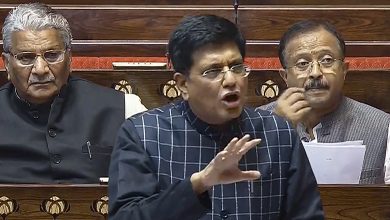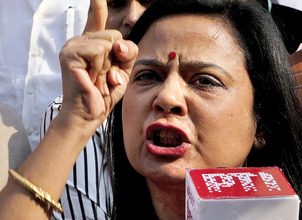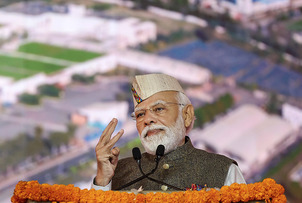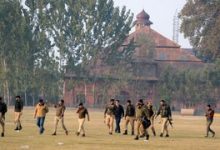Joshimath still to see enough long-term measures to address land subsidence, say experts
Dehradun, Apr 23 (PTI) Nearly four months since Joshimath made headlines as the “sinking town”, the gateway to Himalayan pilgrimage sites is yet to see enough curative steps that address the land subsidence issue, environmental experts have said.
People in unsafe zones have been moved to safety, cracks in the roads filled and unsafe buildings demolished but environmentalists feel long-term measures to save the town from further damage are yet to be initiated.
More than 100 days have passed since the crisis reared its head in early January but cracks have still not stopped appearing in the hill town, which is situated on old landslide rubble.
The cracks that appeared in buildings, roads and public facilities in Joshimath have not widened further of late but sporadic appearances of newer ones leave no room for complacency, said locals.
Atul Sati, the convenor of the Joshimath Bachao Sangharsh Samiti, told PTI, “Cracks are still appearing here and there.”
Sati was the first to raise the issue of land subsidence in the town.
During this pilgrimage season, which started with the opening Yamunotri and Gangotri temples on Saturday, the state government expects a record-breaking influx of devotees in Joshimath.
The locals fear that the huge influx of pilgrims would further increase the pressure on the hill town.
The pilgrimages to Badrinath and the Sikh shrine of Hemkund Sahib begin on April 27 and May 20, respectively.
Joshimath Municipality Chairman Shailendra Panwar noted that there was a marked improvement in the conditions.
The people are safe in the relief camps, unsafe hotels and rest houses demolished, buildings in danger zones vacated and the distribution of compensation among the affected people is underway. However, the danger continues to persist, he said.
Prefabricated 2-BHK houses have been built in Dhak for people living in temporary relief camps but they do not seem interested to move there, Panwar added.
The two major reasons for this are the lack of basic facilities in these houses and their location about 10 kilometres from Joshimath, the Joshimath Municipality chairman said.
“How can people go so far from their lands, leaving their livestock behind?” Panwar asked.
Forty-eight affected families received a cumulative compensation of Rs 11.69 crore as part of a rehabilitation package by April 20 and the process is still underway but the kind of urgency with which long-term steps should have been taken to save the town from further subsidence is not visible on the ground, experts said.
Saving Joshimath is not being accorded the kind of priority it deserves, Chandi Prasad Bhatt, the pioneer of the Chipko movement, told PTI.
The need to strike at the root cause of the crisis seems to have taken a backseat, Bhatt said, adding that rehabilitation of the people and active steps to address the core problem should go side by side.
Bhatt, who was part of the Mishra Committee that first warned of the land subsidence issue in Joshimath in 1976, said stopping soil erosion by the Dhauli and the Alaknanda rivers beneath the hill town should be taken up on priority.
Reinforced Cement Concrete blocks of at least 10 metres each should be erected from the banks of the two rivers under Ravigram up to Marwari bridge to stop soil erosion, he said.
Bhatt also called for proper drainage of water from local ponds, streams located above Joshimath town such as those in Auli and local households to allow it to empty into the rivers below after treatment.
The recommendations were part of the Mishra Committee report that unfortunately could not be acted upon by successive governments, he added.
Bhatt (88), who was conferred with Padma Bhushan in 2005 for his contribution to environmental conservation, said there should be a change in the traditional methods of construction, mining controlled and the use of explosives stopped completely.
Hill cutting for the construction of roads should be discouraged and alternative technologies that reduce the risk of mountain collapse adopted, he suggested.
Expert panels with representatives from organisations such as the Geological Survey of India and the National Institute of Remote Sensing have examined the subsidence issue from different angles and submitted their reports to the Centre.
However, the reports are yet to be made public.
An environment expert, requesting anonymity, said satellite data analysis and geophysical subsurface investigation suggested that the crisis in Joshimath was caused by underground hydrological imbalance.
The cracks appeared in 868 houses in Joshimath, of which 181 are located in the ‘Unsafe Zone’. According to data from the state government’s Disaster Management department, 586 people from 152 families have been living in the temporary relief camps built around the town for months.
The Joshimath Bachao Sangharsh Samiti, which is leading the agitation to protect the interests of the town and its citizens, recently called off its sit-in protest for 20 days following a written assurance from the district administration to look into its 11-point list of demands.
The demands include permanently scrapping the NTPC’s Tapovan-Vishnugad hydel power and the Helang-Marwadi bypass road projects that it holds responsible for the subsidence crisis. It has also demanded that the entire town be declared disaster-hit.
The Samiti has also demanded making the scientific study public.
“Our sit-in protest was called off on Thursday evening on the 107th day of the stir. We have taken some time for ourselves. We have to prepare ourselves for the next phase of the struggle. We have to sustain the fight until the people get their due,” Sati, the Samiti’s convenor, told PTI.
“We will resume our agitation again on May 11 after reviewing the action taken by the administration on its assurances,” he added.
Sati expressed satisfaction with the size of the rehabilitation package but said the process was complicated and slow.
“The compensation being awarded to the affected people at the CPWD (Central Public Works Department) rate of Rs 31,000 or Rs 36,000 per square metre is okay but the process is complex and slow. It should be simplified and expedited,” he said.
Attributing the attention being paid to the subsidence issue in Joshimath to a sustained agitation by the Samiti, Sati said all this would not have happened if it had not kept up the pressure on the administration.








